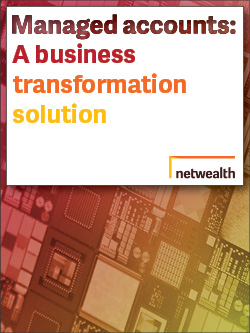Stanford Brown is a successful, self-licensed firm that manages in excess of $1.2 billion. Their clients come from a broad range of backgrounds, and include medical professionals, mid and senior level executives, individuals and families, business owners and corporations.
While their clients are typically highly successful in their chosen pursuits, what they also have in common is a need for sound financial coaching and unwavering counsel to act as a sounding board for all financial decisions and challenges.
Stanford Brown clients are looking for tailored, logical advice explained in an easy to understand manner. They seek an experienced, capable and safe set of hands to help them navigate their changing circumstances over time, and to help nurture, broaden and preserve their wealth.
What prompted Stanford Brown to consider a managed account service?
It was the inefficiencies in the previous advice process primarily. Our advisers met with clients 2 or 3 times a year and changes which we had made to the standard portfolios would be implemented in that meeting. This meant that a client might wait for up to six months for a portfolio change to be implemented on their particular portfolio. Outside this regular client review cycle, any change we felt needed to be effected immediately required an “all hands to the pump” approach.
We wanted to give advisers and clients confidence that the immediacy of our investment decision making could be translated into an immediacy of implementation.
The other key motivation was our desire to achieve back office efficiencies. A smaller advice business can absorb the impact of a portfolio change within normal staffing levels. As our business is approaching 1,000 clients the administrative burden made finding a better solution critical.
What comprised your standard portfolios and how were they developed? Has there been any change since the move to a managed account approach?
Our Investment Committee (IC) meets every month, reviewing asset allocation quarterly and in the intervening two meetings making any necessary investment changes. The IC captures both the advice and formal investment views through its membership of Jonathan Hoyle, Vincent O’Neill, Hamish Harvey, Independent Adviser Don Stammer and our Chief Investment Officer Ashley Owen.
The portfolios were made up of managed funds and ETFs and were all held on platforms. Like many advice groups, we follow a risk profile based approach. For some clients, of course, legacy assets or assets held for tax efficiency reasons are held in addition to the standard portfolios.
Since moving to a managed account, there hasn’t been any change to the type of portfolio we recommend to clients – it hasn’t lead us to hold more direct stocks for example because we just don’t believe advisers or dealer groups should be making individual stock decisions.
However, the managed account process has enabled us to include a portfolio managed by DNR as a very effective way of ensuring that client’s directly held stocks are managed efficiently.
Now that the managed account service is well embedded, 70%- 90% of each client’s portfolios are held in the service. The balance tends to be either client specific investments or investments we recommend but which don’t fit well in a managed account service, for reasons such as illiquidity. Older clients, with longer established portfolios and sometimes more complex circumstances, are more likely to have investments outside the managed account service.
Managed accounts: A business transformation solution
Better understand the different types of managed account structures that are available and their pros and cons
How did you choose Netwealth as your provider?
The selection process took place over an extended period and our decision process was concerned with a number of factors:
- Technology for portfolio management and rebalancing
- General platform functionality
- Strong resourcing in the organisation overall, including a strong financial basis
- Someone we felt would be an excellent business partner
- A legal structure which we felt presented low risk and would be easy to explain to clients.
As a manager of your own Managed Account portfolios, what was your experience of the Netwealth due diligence process?
We found Netwealth to be pretty rigorous about this. Lonsec were asked to review our Investment Committee and investment process. Since we already had a well-developed process and a team with considerable experience we found the process thorough but not daunting.
The due diligence process since then has been thorough but not intrusive. We know that they are monitoring the mandates and our compliance with it.
How was the service presented to clients and what has been their response?
Both the clients and advisers had known for some time that we were considering this approach. The client response has been fantastic because they have actually experienced the benefits of a more proactive approach to portfolio management.
Clients know that Stanford Brown is part of the Lunar Group and we had no hesitation in using the Lunar brand for the service and platform. For clients, this symbolised an improvement to what we think they recognised was already and excellent investment process.
Advisers too, because our service proposition has focused on issues other than security selection and stock picking, were well prepared for their client relationships to be enhanced when we actually implemented the service. We didn’t provide any incentives to advisers to prefer this service over the traditional “recommendation and acceptance” model but the uptake has been pretty complete.
Our advisers were already explaining to clients that key investment decisions were made by the Investment Committee and were already using their expertise as a strength of the Stanford Brown service. Advisers recognised that moving to managed accounts meant their time spent with clients could be more productively spent on key issues that were key to clients rather than explaining the performance of individual investments.
What would your advice be to another group considering moving to a managed account service?
- Understand your advice proposition and make sure that it fits a managed account service
- Develop a key requirements document which you agree internally
- Run a rigorous RFP based on those key requirements and support for the advice proposition
- Make sure that you understand the competing offers in depth
- Make sure that what is being offered is a strong service partnership such as we have developed with Netwealth
- Take the advisers on the journey early.

The problem Stanford Brown were looking to solve
- The technology used by the incumbent was not able to provide the level of flexibility and sophistication required to support both the business and ongoing client needs Inconsistency in the way client portfolios were structured
- Inefficient implementation of portfolio changes, typically requiring additional resources to be diverted at the expense of other important business activities
- Inability to efficiently deliver on investment philosophy

The solution (with Netwealth)
- A well-defined and formalised investment proposition for clients
- A range of multi-asset tactical asset allocation portfolios that can be used efficiently across different client segments
- Embedded investment management fee relating to the ongoing management and development of Stanford Browns investment proposition for clients
- Highly scalable and efficient back office solution
- Equitable and consistent experience for clients

Why Netwealth
- Specialist managed account provider selected after 2 years of research
- The Netwealth platform supports high levels of customisation, that is important to ensure best of breed products and investments can be offered as our own and as our clients’ needs change
- Ability to partner with other best of breed SMA managers utilising sophisticated Model of Model technology
- High levels of governance, resourcing and corporate stability
- Flexibility and commitment to respond to changing requirements, e.g. refactoring of algorithm for illiquid funds
More from the Managed Accounts Special Report
Exploring the different managed account options
Six questions to consider when implementing a managed account solution
